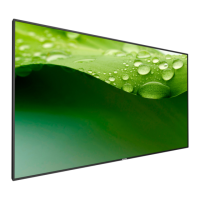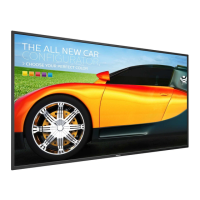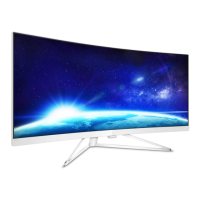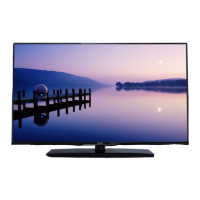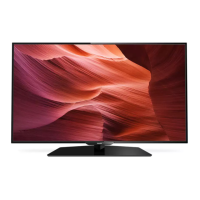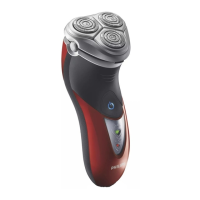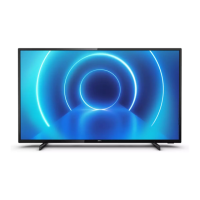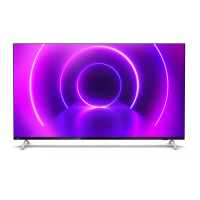Do you have a question about the Philips BDL5530QL and is the answer not in the manual?
General warnings and precautions for safe operation and handling of the display.
Explains the meaning of important safety symbols used in the manual.
Instructions and recommendations for connecting and using the public information display.
Lists essential safety measures to prevent hazards like fire, shock, and injury.
Advises on positioning the display securely to prevent tipping and injuries, especially to children.
Declares product conformity with relevant European Union standards and directives.
Provides information from the US Federal Communications Commission regarding digital device compliance.
Safety warning specifically for users in the United Kingdom regarding earthing.
Instructions for responsible disposal of the display at the end of its service life.
Information on recycling, ENERGY STAR, and hazardous substance restrictions for different regions.
Steps for safely opening the package and checking contents.
List of items included in the package to verify upon receipt.
Important considerations and warnings before and during installation.
Guide on how to mount the display on a wall using standard mounting kits.
Specifies the VESA mounting hole patterns for compatible brackets.
Guidelines for ensuring adequate airflow around the mounted display.
Instructions on how to use the remote control sensor and interpret the power indicator.
Details the buttons and their functions on the display's control panel.
Identifies and describes all input and output ports on the display.
Explains the basic functions and buttons of the remote control.
Guide on setting a unique ID for the remote control to manage multiple displays.
Instructions for inserting and handling batteries for the remote control.
Information on the optimal distance and angle for using the remote control.
How to connect video devices like DVD players, VCRs, and VCD players.
Step-by-step guide for connecting via the Component video input.
Instructions for connecting through the Video Source (Y/CVBS) input.
Guide for connecting a video source via the HDMI input.
How to connect a PC using the VGA (D-Sub) input.
Instructions for connecting a PC via the DVI-D input.
Guide for connecting a PC using the HDMI input.
How to connect audio sources to the display.
Details on linking external audio devices for sound output.
Instructions for connecting displays in a daisy-chain for control.
How to select and view content from connected external devices.
Options for adjusting the aspect ratio and display format of the picture.
How to play media files from a network using DLNA.
Guide to configuring the network for streaming media files.
Instructions for using the Digital Media Player (DMP) function.
Guide on setting up the display as a Digital Media Renderer (DMR).
How to play media files directly from a USB storage device.
Options and controls for playing music files.
Options and controls for playing movie files.
How to view photos and create slideshows.
Instructions for using the built-in Opera web browser.
Adjustments for picture quality, including brightness, contrast, and color.
Options for adjusting audio output, including volume, equalizer, and surround sound.
Configuration for creating video walls by tiling multiple displays.
Configuration options for connecting the display to a network.
Settings for managing internal and external storage, including USB AutoPlay and copying.
Various system settings like language, monitor ID, clock, and scheduling.
Basic explanation of pixels and sub-pixels within a display.
Categorization and definition of different pixel and sub-pixel defects.
Description and examples of bright dot defects (always lit pixels).
Description and examples of dark dot defects (always off pixels).
Tolerances for the spacing between pixel defects to ensure quality.
Defines the acceptable levels of pixel defects for warranty claims.
Guidance on identifying and minimizing the appearance of Mura on the display.
Detailed instructions for cleaning the display's front panel and cabinet safely.
A guide to diagnosing and resolving common display problems and symptoms.
Detailed technical data about the display's screen, resolution, and performance.
Technical details and specifications for all connection ports.
Overall technical specifications including power, dimensions, and weight.
Operating and storage conditions for temperature, humidity, and altitude.
Technical details regarding the display's built-in speakers.
Supported video file types, containers, codecs, and bitrates for USB playback.
Supported image file types and resolutions for USB playback.
Supported resolutions and timings for VGA input.
Supported resolutions for Standard Definition Television inputs.
Supported resolutions for High Definition Television inputs.
General warnings and precautions for safe operation and handling of the display.
Explains the meaning of important safety symbols used in the manual.
Instructions and recommendations for connecting and using the public information display.
Lists essential safety measures to prevent hazards like fire, shock, and injury.
Advises on positioning the display securely to prevent tipping and injuries, especially to children.
Declares product conformity with relevant European Union standards and directives.
Provides information from the US Federal Communications Commission regarding digital device compliance.
Safety warning specifically for users in the United Kingdom regarding earthing.
Instructions for responsible disposal of the display at the end of its service life.
Information on recycling, ENERGY STAR, and hazardous substance restrictions for different regions.
Steps for safely opening the package and checking contents.
List of items included in the package to verify upon receipt.
Important considerations and warnings before and during installation.
Guide on how to mount the display on a wall using standard mounting kits.
Specifies the VESA mounting hole patterns for compatible brackets.
Guidelines for ensuring adequate airflow around the mounted display.
Instructions on how to use the remote control sensor and interpret the power indicator.
Details the buttons and their functions on the display's control panel.
Identifies and describes all input and output ports on the display.
Explains the basic functions and buttons of the remote control.
Guide on setting a unique ID for the remote control to manage multiple displays.
Instructions for inserting and handling batteries for the remote control.
Information on the optimal distance and angle for using the remote control.
How to connect video devices like DVD players, VCRs, and VCD players.
Step-by-step guide for connecting via the Component video input.
Instructions for connecting through the Video Source (Y/CVBS) input.
Guide for connecting a video source via the HDMI input.
How to connect a PC using the VGA (D-Sub) input.
Instructions for connecting a PC via the DVI-D input.
Guide for connecting a PC using the HDMI input.
How to connect audio sources to the display.
Details on linking external audio devices for sound output.
Instructions for connecting displays in a daisy-chain for control.
How to select and view content from connected external devices.
Options for adjusting the aspect ratio and display format of the picture.
How to play media files from a network using DLNA.
Guide to configuring the network for streaming media files.
Instructions for using the Digital Media Player (DMP) function.
Guide on setting up the display as a Digital Media Renderer (DMR).
How to play media files directly from a USB storage device.
Options and controls for playing music files.
Options and controls for playing movie files.
How to view photos and create slideshows.
Instructions for using the built-in Opera web browser.
Adjustments for picture quality, including brightness, contrast, and color.
Options for adjusting audio output, including volume, equalizer, and surround sound.
Configuration for creating video walls by tiling multiple displays.
Configuration options for connecting the display to a network.
Settings for managing internal and external storage, including USB AutoPlay and copying.
Various system settings like language, monitor ID, clock, and scheduling.
Basic explanation of pixels and sub-pixels within a display.
Categorization and definition of different pixel and sub-pixel defects.
Description and examples of bright dot defects (always lit pixels).
Description and examples of dark dot defects (always off pixels).
Tolerances for the spacing between pixel defects to ensure quality.
Defines the acceptable levels of pixel defects for warranty claims.
Guidance on identifying and minimizing the appearance of Mura on the display.
Detailed instructions for cleaning the display's front panel and cabinet safely.
A guide to diagnosing and resolving common display problems and symptoms.
Detailed technical data about the display's screen, resolution, and performance.
Technical details and specifications for all connection ports.
Overall technical specifications including power, dimensions, and weight.
Operating and storage conditions for temperature, humidity, and altitude.
Technical details regarding the display's built-in speakers.
Supported video file types, containers, codecs, and bitrates for USB playback.
Supported image file types and resolutions for USB playback.
Supported resolutions and timings for VGA input.
Supported resolutions for Standard Definition Television inputs.
Supported resolutions for High Definition Television inputs.
| Screen Size | 55 inches |
|---|---|
| Resolution | 1920 x 1080 pixels |
| Brightness | 500 cd/m² |
| Response Time | 8 ms |
| HDMI Ports Qty | 2 |
| PC Interface | VGA |
| Commercial Use | Yes |
| Depth | 60 mm |
| Viewing Angle | 178 degrees |
| Connectivity | HDMI, VGA, USB |
| Video Interface | HDMI |
